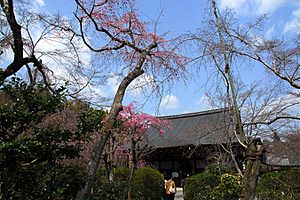Kashō (early Heian period) facts for kids
For the "Kashō" era which started in 1106 -- sometimes romanized as "Kajō", see Kashō (late Heian period).
Kashō (嘉祥), also known as Kajō, was a special way to name years in ancient Japan. Think of it like how we have "years" today, but back then, they also used "era names" for periods of time. This era came after an era called Jōwa and before Ninju.
The Kashō era began in June 848 and finished in April 851. During this time, two emperors ruled Japan: Emperor Ninmyō and his son, Emperor Montoku.
Key Events of the Kashō Era
- February 18, 848 (Kashō 1): A very important person named Fujiwara Yoshifusa was given a high position in the emperor's court. His daughter later married Emperor Montoku and became the mother of another emperor, Emperor Seiwa.
- 848 (Kashō 1): A rare white tortoise was found in a place called Bungo Province. Finding a white tortoise was seen as a very good sign, bringing good luck to the country.
- 849 (Kashō 2): An ambassador, who is like a special messenger from another country, came from Baekje (an ancient kingdom in Korea) and was welcomed at the Japanese court.
- 849 (Kashō 2): Emperor Ninmyō celebrated his 40th birthday. This was a big event for the court and the people.
- 849 (Kashō 2): The emperor took a grand tour through the capital city. It was a big parade for everyone to see.
- 850 (Kashō 3): The emperor made an official visit to his mother's home. This showed respect and care for his family.
- May 6, 850 (Kashō 3): Emperor Ninmyō passed away at the age of 41. His oldest son, Montoku, then took over as the new emperor. This process of taking the throne is called senso. Soon after, Emperor Montoku officially accepted all the duties and powers of being the ruler in special ceremonies called sokui.
- 850 (Kashō 3): Tachibana no Kachiko died. She was the wife of a past emperor, Emperor Saga, and the mother of Emperor Ninmyō. She was also the grandmother of the new Emperor Montoku. She had started a Buddhist temple called Danrin-ji. This temple later grew and changed into the famous Tenryū-ji temple, which still exists today.
Related Information
- Heian period
- National Diet Library, "The Japanese Calendar" -- a look at Japan's old calendars with pictures from the library

All content from Kiddle encyclopedia articles (including the article images and facts) can be freely used under Attribution-ShareAlike license, unless stated otherwise. Cite this article:
Kashō (early Heian period) Facts for Kids. Kiddle Encyclopedia.

